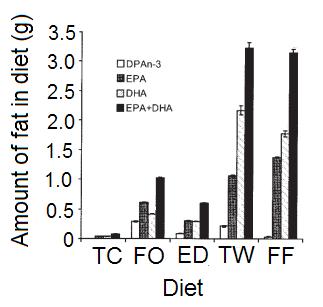Certain nutrients are difficult to consume at the recommended level because they are present in few readily available foods, and largely absent from foods consumed regularly in a typical Western diet. One such group of nutrients are the n-3 fatty acids such as eicosapentanoic acid (EPA, C20:5 (n-3)), docosahexanoic acid (DHA, C22:6 (n-3)) and α-linolenic acid (ALA, C18:3 (n-3)). Deficiency of these fatty acids may to lead to inflammation and oxidative stress, and subsequent metabolic changes may ultimately increase the risk of cancer, cardiovascular disease and diabetes. Incorporating fatty fish and fish oil supplements into the diet has been shown by research to increase the n-3 content of plasma phospholipids, but some controversy surrounds the use of plant sources of n-3 oils such as flax and hemp. This is because plant based ALA is not efficiently converted to EPA or DHA in humans.
Because of the difficulties in achieving sufficient intakes, researchers1 have investigated the ability of a variety of diets to supply sufficient quantities of n-3 fatty acids. The typical Canadian diet was compared to the typical diet containing fish oil capsules (FO), the typical diet enriched with ALA containing functional foods (ED), a traditional whole foods and fish diet (TW), and a whole food diet with added fish oils and added ALA containing functional foods (FF). The diets were assessed for their nutrient content and the costs of the diets were also assessed. The FO, ED, TW and FF diets contained significantly more n-3 fatty acids than the typical Canadian diet as expected (1.03, 0.59, 3.23 and 3.15 versus 0.08g of EPA and DHA, respectively). However, the cost of the n-3 fortified diets also increase over the typical Canadian diet (FO: +$0.53, TW: +$0.82, ED: +$0.93, FF: +$1.63.
These results support previous research that has reported an increase in costs with higher quality diets (here). This may explain the link between poverty and disease, because access to cheaper, lower quality food may encourage the avoidance of more expensive food that provides health benefits. The low concentrations of n-3 fatty acids in a typical Canadian diet are illustrated in this study and shown in figure 1, and the use of functional foods may be one solution to these low intakes. However, this would come at a cost to the consumer and may be prohibitive for those with lower incomes. Studies of Eskimo populations in North America have shown that their intakes of fish and marine oils are much higher than those of control populations eating a typical Western diet (here). This may explain their protection from certain lifestyle diseases.
Figure 1. Quantities of DHA(DHA, C22:6 (n-3)), EPA (EPA, C20:5 (n-3)) and ALA (ALA, C18:3 (n-3)) in various diets. TC: typical Canadian diet, FO: typical diet containing fish oil capsules, ED: the typical diet enriched with ALA containing functional foods, TW: a traditional whole foods and fish diet, FF: and a whole food diet with added fish oils and added ALA containing functional foods.
RdB

